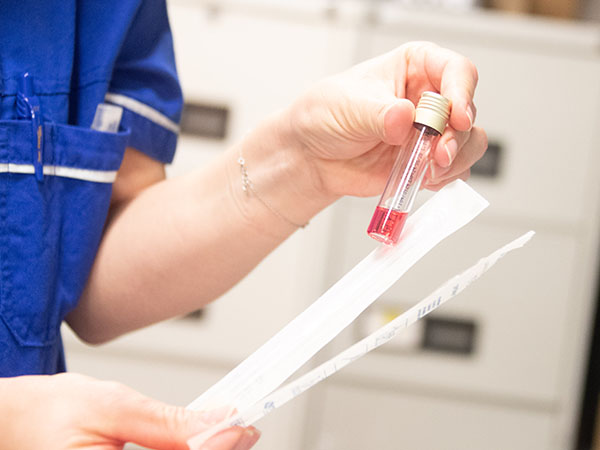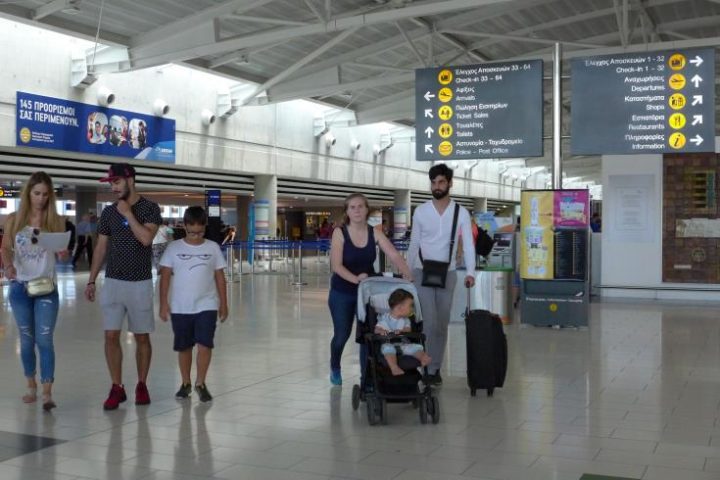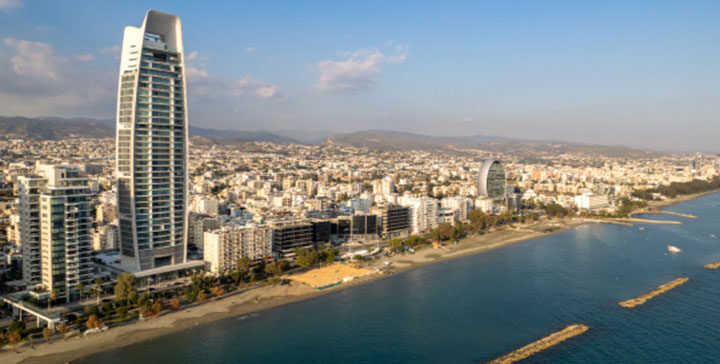Cyprus is experiencing a déjà vu as the daily coronavirus cases announced during the past two days resemble the announcements at the early stages of the COVID-19 outbreak when the country went into lockdown in mid-March.
Cyprus is seemingly losing control with the pandemic as it is once again reporting double digit cases after a period of three months, pushing the transmission rate R(t) to above 1, according to the latest epidemiological updated as of July 28.
For three months, the island’s health authorities had been reporting a low transmission rate, as calculation models reported an R(t) of under 1.
However, this is now in the past with three out of four models included in the ministry’s latest epidemiological report indicating that the rate is now close 1.2 to 1.3. That is, each person tested positive for COVID-19 transmits the virus to more than one person.
The high end of one of the four models has the Cyprus transmission rate at 1.92.
The report was updated with data up to July 28, with a total of 1,066 COVID-19 cases and 26 deaths (case fatality rate: 2.4%) being reported in the Republic of Cyprus.
It does not include cases reported during the last two days, having experts worried that the actual Rt indicator is now well above 1. The number of local infections in recent weeks has grown to surpass those of imported infections which was the case in the previous two reports.
On Thursday, ten new coronavirus cases were recorded, of which six resulted from 280 samples taken through random testing in Limassol. The previous day saw Cyprus recording 13 cases, with seven in Limassol.
Even without including the local infections of the past week, the number of local infections within the last 30 days is still higher than that of imported cases.
According to the latest report, in the last 30days (29 June – 28 July), of 72 cases reported, 49% (n = 35) were imported, and 51% (n = 37) were locally-acquired.
The majority of recent cases were reported in Limassol (41.7%; n = 30), where 80% of them (n = 25) were locally-acquired.
Overall, of 921 cases for which the place of exposure was known, locally acquired infections (index cases and close-contacts of confirmed cases) were 712 (77.3%), of these 8% (n =57) were related to a healthcare facility (General hospital in Paphos) and 11.9% (n = 85) were reported in Aradippou municipality.
Travel history and residence abroad
In total, 22.7% (n =209) of laboratory-confirmed COVID-19-cases had a history of travel or residence abroad during the 14 days prior to symptom onset (imported).
The mortality rate for COVID-19 is 3 per 100,000 population.
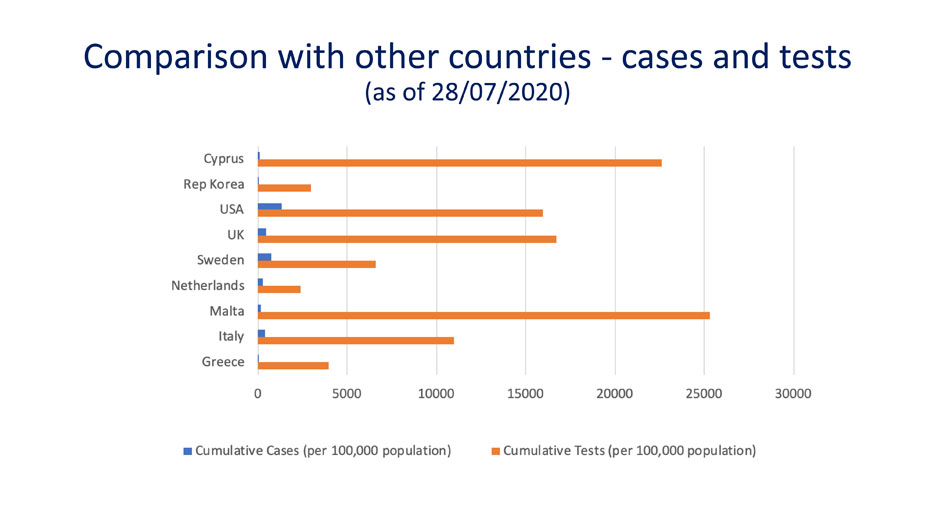
Eighteen deaths (73%) occurred among men and seven (27%) in women; the median age of all deaths was 75 years (IQR: 66-79 years).
Nine deaths were reported among residents in Larnaca, eight in Paphos, four in Nicosia, three in Famagusta, and two in Limassol.
For 19 of the deaths, COVID-19 was the underlying cause of death (COVID-19 CFR: 1.8%).
In total, 17.2% (n = 183) of people with COVID-19 received hospital care, and four (2.2%) are still hospitalised (either for treatment of COVID-19 symptoms or for pre-existing conditions).
The median age of hospitalised patients was 62 years (IQR: 48-73years).
Hospitalised cases were mainly males (n = 119; 65%).
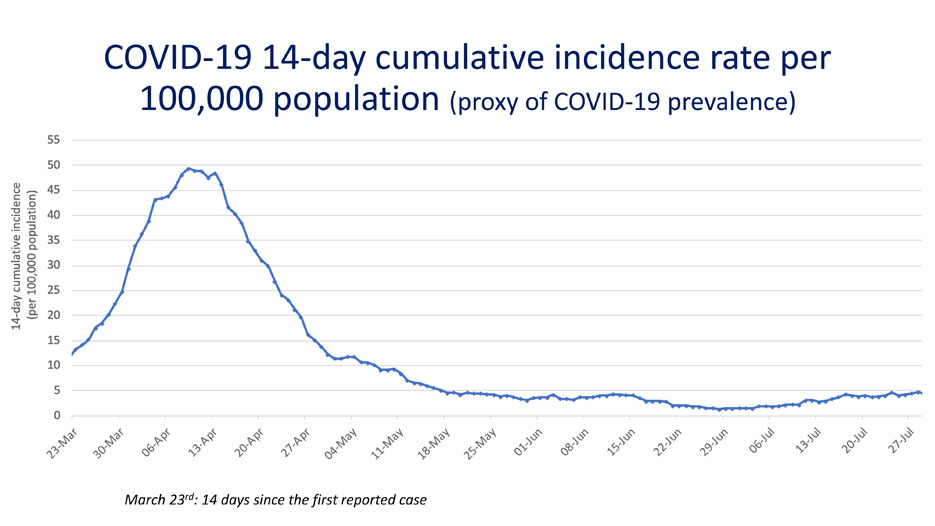
Overall, 32 cases (17.5% of all hospitalised patients) have been admitted to ICU, while currently there are no cases in ICU (as of July 28).
A total of 27 ICU patients (84.4% of all ICU patients) have been intubated, and currently there no patients intubated. The overall median length of stay in ICU (for all 32 ICU cases) was 11 days.
The median age of patients admitted to ICU was 65.5 years (IQR: 56-75 years). ICU patients are mainly male (n = 23; 71.9%).
Among ‘live’ cases, 856 (82.3%) have recovered (without symptoms and with two negative tests following their diagnosis or released 21 days after diagnosis).
The median time between the second negative result and the first date of sampling was 25 days (IQR: 19-37days).
The median age of all cases is 43 years, with 48% females and 52% males.
By age group, cases included 69 infants, children and adolescents aged 0-17 years-old (6.4%), 762 adults aged 18-59 years (71.5%), and 235 persons aged 60 years and older (22.1%).
Most cases in Nicosia
Of the 1,066 laboratory-confirmed COVID-19-cases, clinical information is available for 98.4% (n = 1,049), of which 35.4% (n = 371) reported no symptoms at diagnosis and 64.6% (n = 678) reported at least one symptom. The most commonly reported symptoms were:
- cough 31.9%
- fever 30.9%
- myalgia 21%
- sore throat 16.1%
- anosmia 12.5%
- shortness of breath 11.1%
Other reported symptoms were diarrhoea, runny nose and headache.
Among these cases, 18.1% are healthcare workers (n = 193), 3.9% physicians (n = 42), 9.2% nurses (n = 98), 1.1% other health occupations (n = 12), and 3.8% auxiliary staff.
A total of 198,113 tests have been performed as of July 28 (22,618.2 per 100,000 population), significantly higher than Italy’s 10,991.3 per 100,000 inhabitants, UK’s 16,648.5 and South Korea’s 3,001.8.

